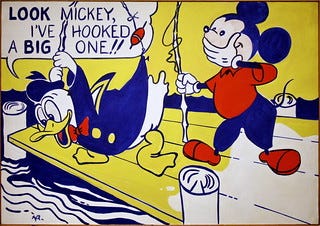Donald Duck: A Tale of Innovation and Patent Woes
Written on
Chapter 1: The Sunken Yacht
In a dramatic plunge, a ship descended into the depths, seemingly lost forever. Along with it, six thousand sheep sank, their carcasses threatening to contaminate Kuwait's waters if swift action wasn't taken. To avert disaster, twenty-seven million buoyant beads cascaded down, racing to rescue the vessel from its watery grave.
In a comic strip from 1949 titled "The Sunken Yacht," Donald Duck demonstrated an unexpected grasp of physics. Stranded by a malfunctioning boat, he (or rather, his creator Carl Barks) had a breakthrough moment. Donald and his nephews utilized a long tube to funnel ping pong balls into their sunken yacht, and as anticipated, it began to rise. Unlike the classic antics of Wile E. Coyote, which hinge on cartoon logic, Barks stumbled upon a concept that, unbeknownst to him, was grounded in reality.

An object, like a ping pong ball, will float if the buoyant force exerted by the water is greater than the gravitational force pulling it down. Although buoyancy is a property of water, it is influenced by the characteristics of the ping pong ball itself. The buoyancy that a ball experiences is determined by its density and volume. For instance, ping pong balls have low density due to their air-filled interiors, which allows them to float, whereas a brick sinks due to its tightly packed molecules. Similarly, a pineapple's buoyancy allows it to stay afloat. Additionally, the size of the ball can affect its buoyancy—larger objects displace more water, resulting in a greater buoyant force.
In essence, ping pong balls indeed float. Each ball that Donald and his nephews added to their yacht contributed to the upward force against gravity. Once they reached a certain number, the combined buoyancy overcame the gravitational pull, causing the boat to surge to the surface.
This principle wasn't merely theoretical; in 2004, the Mythbusters tested the idea and found that a 3,500-pound fiberglass boat could be lifted using just 27,000 ping pong balls—far fewer than the 50,000 they had anticipated. They deemed the concept "plausible but not practical," a remark that could be seen as a slight to Karl Kroyer, who had sought a patent for a similar concept four decades earlier. Tragically for Kroyer, his patent application was rejected due to a cartoon character—Donald Duck.
Kroyer didn't initially aim to create a method for raising sunken vessels. Following the capsizing of the Al Kuwait, which carried six thousand sheep, he was approached by the ship's insurance company for a solution to their urgent predicament. The exact details of how the resolution was conceived remain unclear, clouded as they are by the murky waters filled with deceased sheep. Some accounts suggest Kroyer was inspired by the comic strip, while others indicate that he simply tasked his team with brainstorming solutions, leading a junior staff member to suggest using "entrapped air" akin to ping pong balls for flotation. Whether the employee recalled the comic is unknown, but the outcome was a remarkable success.

The team gathered 65 tons of expanded polystyrene beads, resembling miniature ping pong balls. Following the comic's plot, they poured bead after bead down the tube, ultimately using 27 million beads to successfully elevate the ship. Kroyer took his idea to patent offices in Germany, the UK, and the Netherlands. He received patents in the first two countries, but his case in the Netherlands gained notoriety. Although his invention was accepted in Germany and the UK, the Dutch office rejected it, citing prior art. Prior art can encompass a variety of sources, from academic journals to comics; if an idea has been publicly shared—even in jest—it's considered fair game. Thus, in the Netherlands, Donald Duck emerged victorious.
But did he truly win? The ship ascended, never to return to the depths. The six thousand sheep were salvaged, ensuring Kuwait's waters were safe once more. Twenty-seven million buoyant beads were the only defense against an impending public health crisis. For Kroyer, who had long aspired to invent as a career and had previously made contributions to the sugar industry, perhaps obtaining a patent was not his true aim. Perhaps the real reward was simply being the hero of the day.
Chapter 2: The Real-World Application
In this next section, we delve deeper into the practical implications of Kroyer's invention and its historical context.
The first video showcases "Donald Duck - Modern Inventions - 1937 (HD)," illustrating how cartoon physics can inspire real-world innovations.
In the second video, "DuckTales: (S2E12) Analysis - Donald's Luck & Della's RETURN! | TheNextBigThing," we explore the enduring legacy of Donald Duck and his influence on invention and creativity.